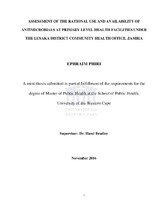| dc.description.abstract | Background: The irrational use of medicines, and increasingly antimicrobials, remains a key health problem in many developing countries including Zambia. Inappropriate, ineffective and inefficient use of medicines is common in health facilities at all levels. There are many factors influencing irrational prescribing and dispensing of antimicrobials including patients, prescribers, dispensers, the supply
system (including industry influences), government regulations and medicines information and misinformation. Study aim: The aim of the study was to assess the rational use and availability of antimicrobials at primary level health facilities under the Lusaka district community health office, Zambia. Study design: The study was a cross-sectional descriptive study, with prospective and retrospective components. A
standardized research methodology, including tools and indicators, adapted from the World Health Organization, was employed. Study population and sampling: The study population included all the 30 government primary level health facilities (health centres) in Lusaka District, from which 20 primary health facilities were sampled using a combination of purposive and random sampling. Using the WHO standard indicators of rational drug use, this study assessed 800 patient encounters, 520 medicines inventory records, and other baseline data, from 20 health facilities at three different levels under the Lusaka district community health office, Zambia.
Data collection: The data collection tools were numbered and labeled. Tool 1: Prescribing Indicator Form was used to collect prescribing data; Tool 2: Patient Care (Pharmacy) Form was used to record dispensing data; Tool 3: Antimicrobial Availability Form for recording data for the availability of the key indicator
antimicrobials and their substitutes; Tool 4: Facility Indicator Consolidation Reporting Form was used for consolidating the data collected for each health facility under study; and Tool 5: Facility Medicines Use Indicator Consolidation Form was used for the consolidation of the drug use data for the entire study. Third year Pharmacy Technology students were trained for the data collection process. The patients were first observed from outside the prescriber's room and the dispensing area for consultation and dispensing times respectively, and then they were interviewed to collect the prescribing and dispensing data. The tools were pre-tested. Data analysis: After data checking and consolidation, quantitative data were categorized into continuous numerical variables. Calculations were done manually and using computerized analysis (Epi Info package) and presented as simple frequency and means. Ethics: Ethical clearance for the study was obtained from University of the Western Cape Senate Research Committee. Permission was obtained from the Lusaka Provincial and District health offices, being the
authorities that are overseeing the health facilities included in the study. Furthermore, permission was obtained from the health centre in-charges. Consent was obtained from healthcare providers and patients. Key results and discussion:
The study found that at the primary level facilities there were more Clinical Officers (55%) than Medical Doctors (25%) and Registered Nurses (20%) in charge of prescribing. The main dispensers were Pharmacy Technologists (85%); there were no Pharmacists available in any of the facilities. A third [259 (32.4 %)] of all the 800 patients in the study were children below 12 years of age. Across the clinics, a mean of 2.94 medicines were prescribed per prescription, with an extremely low rate of prescribing drugs by generic name (36.7%). The proportion of prescriptions including an antibiotic was 36.2 % and 3.4 % included an injectable drug. Linking the antimicrobials and injections to patient diagnoses indicated that many were probably irrational, prescribing decisions. Amoxicillin and metronidazole were by far the most commonly prescribed antimicrobials at 32.0 % and 17.2 % of total antimicrobials, respectively. The essential drugs list was available in 80.0% of facilities and a high percentage of medicines were prescribed from the essential medicines list (81.2%). The overall mean percentage of medicines packages correctly labeled was considerably low at 44.8 %. The average consultation time was short at 4.0 (range 1-8.4) minutes, whereas the dispensing times were
equally short and averaged at 116.6 (range 15-360) seconds, with the range of 15 to 360 seconds. The average percentage of first line antimicrobials available at health facilities was 79 %; and the average percentage of second line, substitute, antimicrobials available was 15 %. Conclusion: In line with studies from other settings, this medicines use study found considerable overuse and irrational use of antimicrobials in the primary health care clinics in Lusaka District. Irrational
medicine prescribing was common and poor dispensing practices were also seen, resulting in poor use of and adherence to medicines and, consequently, poor therapeutic outcomes. Recommendations: Several recommendations have been formulated. They include: Reinforcing the Drug Therapeutic Committees (DTCs) at the national and the local facility level to help manage medicines use;
clarification of prescribers and dispensers roles and responsibilities; development, enforcement or adaption of standard operating procedures (SOPS) for prescribing and dispensing; and improvement of prescribing and dispensing practices through introduction of appropriate education, supervision and audit. | en_US |

